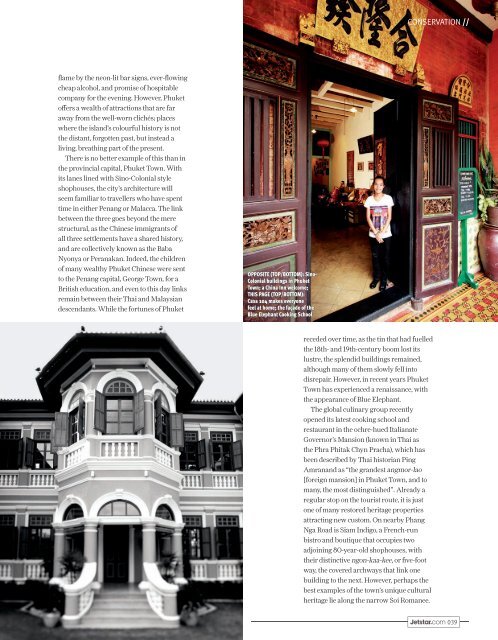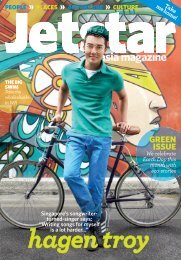Create successful ePaper yourself
Turn your PDF publications into a flip-book with our unique Google optimized e-Paper software.
fl ame by the neon-lit bar signs, ever-fl owing<br />
cheap alcohol, and promise of hospitable<br />
company for the evening. However, Phuket<br />
off ers a wealth of attractions that are far<br />
away from the well-worn clichés; places<br />
where the island’s colourful history is not<br />
the distant, forgotten past, but instead a<br />
living, breathing part of the present.<br />
There is no better example of this than in<br />
the provincial capital, Phuket Town. With<br />
its lanes lined with Sino-Colonial style<br />
shophouses, the city’s architecture will<br />
seem familiar to travellers who have spent<br />
time in either Penang or Malacca. The link<br />
between the three goes beyond the mere<br />
structural, as the Chinese immigrants of<br />
all three settlements have a shared history,<br />
and are collectively known as the Baba<br />
Nyonya or Peranakan. Indeed, the children<br />
of many wealthy Phuket Chinese were sent<br />
to the Penang capital, George Town, for a<br />
British education, and even to this day links<br />
remain between their Thai and Malaysian<br />
descendants. While the fortunes of Phuket<br />
OPPOSITE (TOP/BOTTOM): Sino-<br />
Colonial buildings in Phuket<br />
Town; a China Inn welcome;<br />
THIS PAGE (TOP/BOTTOM):<br />
Casa 104 makes everyone<br />
feel at home; the façade of the<br />
Blue Elephant Cooking School<br />
receded over time, as the tin that had fuelled<br />
the 18th- and 19th-century boom lost its<br />
lustre, the splendid buildings remained,<br />
although many of them slowly fell into<br />
disrepair. However, in recent years Phuket<br />
Town has experienced a renaissance, with<br />
the appearance of Blue Elephant.<br />
The global culinary group recently<br />
opened its latest cooking school and<br />
restaurant in the ochre-hued Italianate<br />
Governor’s Mansion (known in Thai as<br />
the Phra Phitak Chyn Pracha), which has<br />
been described by Thai historian Ping<br />
Amranand as “the grandest angmor-lao<br />
[foreign mansion] in Phuket Town, and to<br />
many, the most distinguished”. Already a<br />
regular stop on the tourist route, it is just<br />
one of many restored heritage properties<br />
attracting new custom. On nearby Phang<br />
Nga Road is Siam Indigo, a French-run<br />
bistro and boutique that occupies two<br />
adjoining 80-year-old shophouses, with<br />
their distinctive ngon-kaa-kee, or fi ve-foot<br />
way, the covered archways that link one<br />
building to the next. However, perhaps the<br />
best examples of the town’s unique cultural<br />
heritage lie along the narrow Soi Romanee.<br />
CONSERVATION //<br />
039

















